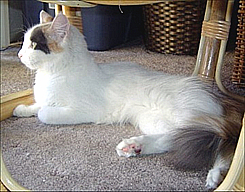|
The Scratching Post
Turkish Van 
The Turkish Van is a rare breed known for its distinctive color pattern. These cats are white with colored markings on their head and tails. The body is moderately long, sturdy, deep-chested and muscular. The head is a broad wedge with prominent cheekbones and a firm chin. The muzzle is rounded. The eyes are slightly large and set at a slant. Eye colors are amber, blue or odd-eyed. The eye color may fade with age. The ears of this breed are wide at the base and moderately large with rounded tips. The insides of the ear are well-feathered. Feathering can also be found on the legs, feet and belly. Facial fur is short. The legs are muscular, long and set wide apart. The silky coat lies flat and has no undercoat. The neck ruff and full tail plume become more prominent with age. A glistening chalk white coat with colored markings on the head and tail are the only colors accepted in this breed.
|
|
Temperament
|
The Turkish Van is action-packed, energetic, intelligent and will literally run circles around you and everything else in the house. These cats are fascinated by water and are known as ?The Swimming Cat? in their native land. Some in this breed will dip their toys in their water dishes or even in the toilet. Others in this breed will learn how to turn on the faucets or flush toilets. Please keep your toilet closed. Make sure you like a very active cat before you acquire a Van. They love interactive toys or anything that moves, including you. Vans can play rough when they are excited, so be cautious. This breed also tends to howl more than meow, takes pleasure in breaking things, and can be very jealous of other animals in the house. Also, given the scarcity of the breed, some veterinarians will not spay or neuter them.
|
|
Weight
|
Male: 12-17 lbs. ; Female: 9-13 lbs.
|
|
Health Problems
|
This breed is generally a strong and healthy cat since breeding the Van with other breeds is not allowed; however, as with most white cats, they have a genetic tendency to deafness.
|
|
Living Conditions
|
Vans can live fine in either an apartment or a house. Though they enjoy being outdoors, they do not require it. Make sure they are provided with plenty of toys and a sturdy scratching post indoors.
|
|
Exercise
|
This active breed enjoys playing and need lots of interactive toys.
|
|
Life Expectancy
|
15 or more years
|
|
Grooming
|
The Van?s coat has no undercoat, is resistant to matting and requires very little grooming.
|
|
Origin
|
Vans were first brought to England in 1955 as the Turkish cats, but this was later changed to Turkish Van to avoid confusion with the Turkish Angora. Although the breed has an ancient lineage, the Turkish Van is a relative newcomer to the United States. The first Van kittens arrived in the United States in the 1970s, but it was not until breeders Barbara and Jack Reark imported two Vans from France in 1983 that the breed began to flourish in North America. Acceptance from many of the cat registries quickly followed. The CFA accepted the breed for championship in 1994 and they remain one of the lesser known and rarer breeds. Demand usually exceeds supply.
|